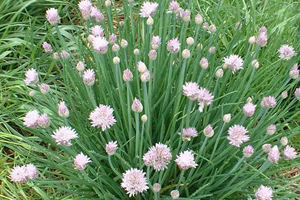|
|

|
|

| Latin Name : Allium sativum L |
| Family : Liliaceae (Alliaceae) |
| Genus : Allium |
| Common names : Garlic, Softneck garlic, harneck garlic, rocambole |
 |
Garlic, native to central Asia and a member of the lily family, is a hardy bulbous perennial widely cultivated in most parts of the world for its edible bulb. The bulb which is used mainly as a flavouring in foods grows beneath the ground. Garlic, one of the oldest vegetable crop contains compounds that are antibacterial, antifungal and reduce blood clotting. It helps to lower blood pressure and is considered as a cure for heart ailments. It contains vitamins A and C, potassium, phosphorous, selenium, and a number of amino acids.
The leaves of garlic are erect, narrow, flat and bladelike, with a crease down the middle. Most varieties will reach 12 to 18 inches tall at maturity. The underground compound bulb consists of groups of white or purplish scales that is usually divisible into 6-20 segments. Each group is referred to as a clove, and the individual cloves form in a round bulb that varies slightly in shape, colour and flavour depending on the variety and on growing conditions. There are more than two dozen varieties of garlic.
Propagation, Planting and Harvesting :
Garlic never produces fertile seeds and must be propagated by dividing the bulbs into individual cloves carefully and planting each clove as a set. It is grown as an annual and planted from September through February.

Garlic prefers a sunny position in a moist, light, well-drained soil with a pH of 4.5 to 8.3. It can tolerate periods without rain, but best results come from plants that receive regular watering. The site selected for planting garlic must have excellent drainage and adequate sunlight. Condition the soil with lots of organic matter, bone meal etc one or two weeks before planting. Add more sand if the soil is clayish. Individual Cloves can be planted 2-3 inches deep with their noses just below the soil surface and 4-6 inches apart. amaged cloves should not be planted to avoid diseases or pests.
Harvest is usually sometime from mid-July through August, about nine months after planting depending upon conditions and the type of garlic. Bulbs should be dug-up when 2-3 leaves turn brown. Be careful not to bruise or injure the bulbs, dig carefully beside the plant and then underneath it with a spading fork to loosen the plant, lift the bulb up and gently remove excess dirt.
Garlic with the entire bulb and stalk, must be well dried and cured after harvest, before being stored. Tie the garlic stalks together about a dozen in a bundle, and hang them up to be dried for two to three weeks in an airy well-ventilated location not under direct sunlight. Once dry, the roots should be trimmed off and the stalk removed about an inch from the head. Bulbs store best with good air circulation on all sides. Bulbs to be saved for later planting can be stored in a plastic bag in the refrigerator for up to 8 months. Fresh garlic is best stored in an open container in a cool, dark place. Bulbs should be able to keep for eight weeks at a time - whereas if you break the cloves off individually, they will begin to dry after about three days.
Problems and Care :
Weeds and drought are two major enemies of garlic. It is important to keep your garlic weeded. Weeds use up moisture needed by your garlic plants and also can harbor molds. Ideally, the plant should receive an inch of water -rain and irrigation per week during leaf development and 1-1/2 inches of water a week after bulbs begin to form in June. The need for water decreases when nearing harvest. Stop irrigation a couple of weeks before the crop is harvested in late July or early August.
They will need a little fertilizer say when the plant has grown to about 6 inches tall to keep them going. Provide well-drained soil to prevent bulb rot and other diseases. Mulch with partially decomposed compost after planting, to prevent weeds, keep soil evenly moist, and provide disease protection.
Questions & Answers |
|||||||||||||||||||||||||||||
| |||||||||||||||||||||||||||||
| |||||||||||||||||||||||||||||
| |||||||||||||||||||||||||||||
| » more... | |||||||||||||||||||||||||||||